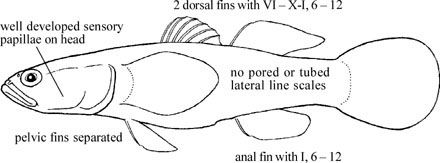ELEOTRIDAE
Sleepers
By Koichi Shibukawa
 Butis butis |
|
Small to moderate sized fishes, usually found in brackish or freshwater areas (rarely in marine). Body moderately elongate, more or less compressed posteriorly; no pored or tubed lateral line scales on body. Teeth usually conical, forming some or more rows in each jaw; sensory-papillae rows well developed on head (and few on body and caudal fin); branchiostegals 6. Two dorsal fins, first one with VI - X flexible spines, second one with I spine and 6 - 12 soft rays; pelvic fins separated, innermost or preceding rays longest; pelvic fin usually with I spine and 5 soft rays. Color: highly variable, typically blackish or grayish brown with dusky mottles, whereas some species have brilliant color with bright yellow and/or red spots.
Similar families occurring in the area. Blenniidae: single dorsal fin (sometimes deep notch developed between spinous and soft portions); teeth incisor-like, forming single row in each jaw. Callionymidae: preopercle with a strong spine; no scales on body; gill opening restricted to a small dorsal or dorsolateral pore; no spines on second dorsal and anal fins. Gobiidae: pelvic fins fused medially one another in many species; five branchiostegal rays. Platycephalidae: many short spines or bony tubercles on head; no spines on second dorsal and anal fins. Tripterygiidae: three dorsal fins. |

|
|